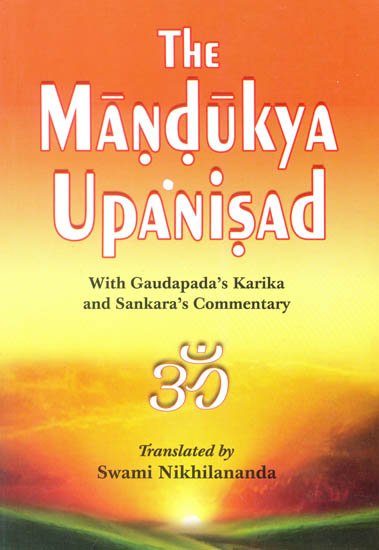Mandukya Upanishad (Gaudapa Karika and Shankara Bhashya)
by Swami Nikhilananda | 1949 | 115,575 words | ISBN-13: 9788175050228
This is verse 2.1 of the Mandukya Karika English translation, including commentaries by Gaudapada (Karika), Shankara (Bhashya) and a glossary by Anandagiri (Tika). Alternate transliteration: Māṇḍūkya-upaniṣad 2.1, Gauḍapāda Kārikā, Śaṅkara Bhāṣya, Ānandagiri Ṭīkā.
Mandukya Karika, verse 2.1
Sanskrit text, IAST transliteration and English translation
वैतथ्यं सर्वभावानां स्वप्न आहुर् मनीषिणः ।
अन्तःस्थानात् तु भावानां संवृतत्वेन हेतुना ॥ १ ॥vaitathyaṃ sarvabhāvānāṃ svapna āhur manīṣiṇaḥ |
antaḥsthānāt tu bhāvānāṃ saṃvṛtatvena hetunā || 1 ||1. The wise declare the unreality of all the objects seen in the dream, they all being located within (the body) and on account of their being in a confined space.
Shankara Bhashya (commentary)
Aum. It has been already said, “Duality does not exist when (true) knowledge arises,” and this is borne out by such Śruti passages as, “It (Ātman) is verily one and without a second,” etc. This is all based merely on the authority1 of the Śruti. It2 is also equally possible to determine the unreality (illusoriness) of duality through pure reasoning; and for this purpose is begun the second chapter which commences with the words Vaitathyam (unreality) etc. The word, Vaitathyam signifies the fact of its being unreal or false. Of what is this (unreality) predicated? Of all objects, both internal3 and external,4 perceived in the dream. It is thus declared by the wise, i.e., those who are experts in the use of the means (pramāṇas) of arriving at true knowledge. The reason of this unreality is stated thus; For, the objects perceived are found to be located within the body. All these entities such as a mountain, an elephant, etc., perceived in the dream are cognized there5 (i.e., within) and not outside the body. Therefore they must be regarded as unreal.
(Objection)—This (“being within”) is no valid reason. A jar and other things on account of their being perceived within a cover, such as a cloth, etc. (cannot be called unreal).
(Reply)—On account of their being confined in a limited space, that is, within the body (where dream objects are cognized). It is not possible for the mountain, the elephant, etc., to exist in the limited space (within the nerves6 of the body) which are within the body.. A mountain does not or cannot exist inside7 a body.
Anandagiri Tika (glossary)
1 Authority of the Śruti—The subject-matter, namely, the illusoriness of duality, has been proved in the first chapter solely on Scriptural authority.
2 It is, etc.—Śaṅkara contends that the illusoriness of the duality can be proved by reasoning also independently of the Śruti. The Scripture, no doubt, convinces those who believe in its authority. But the philosophy of Vedānta can hold its ground against those who do not believe in the authority of the Vedas, e.g., the Buddhists, the Jains, the Cārvākas and others. All fair discussions are based on reason which is the common platform for all. It betrays ignorance of higher Vedānta to say that the reasoning employed in the Vedānta philosophy to arrive at the Ultimate Truth is always subservient to Scriptural authority. The second chapter of the Kārikā establishes the unreality of duality through reasoning independent of Scriptural authority.
3 Internal—i.e., such ideas as those of happiness, misery, etc.
4 External—e.g., a pot, a mountain, etc. This distinction between internal ideas and external objects is made here from the dream standpoint. But from the waking standpoint all dream experiences are internal.
5 There—i.e., within the body. The dream is an activity of the mind and according to the common-sense view, mind is within, the body. Therefore objects seen in dream are said to exist within the body.
6 Nerves—It is said in the Scriptures that the mind moves about during the time of sleep along some nerves and this produces the dream experiences.
7 inside, etc.—If a mountain cannot exist within a body, it is still more impossible for it to exist within a nerve, which is an old-world view.
